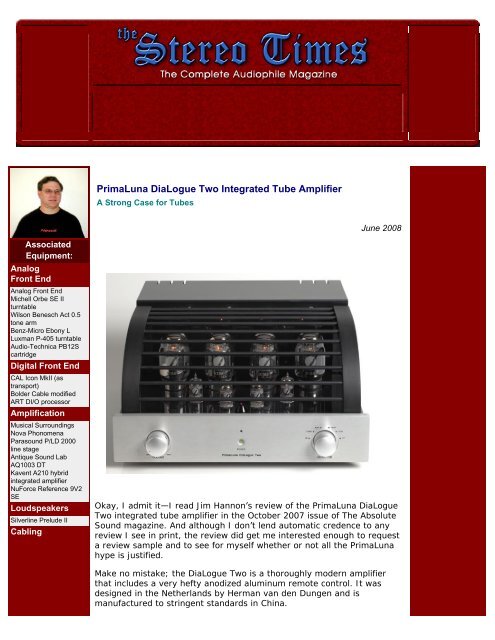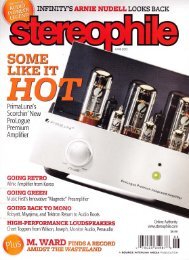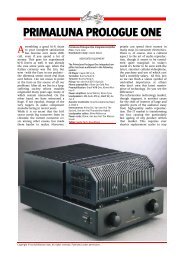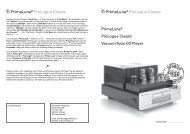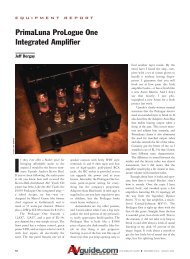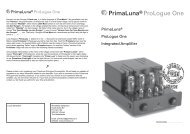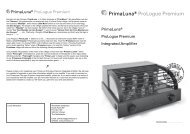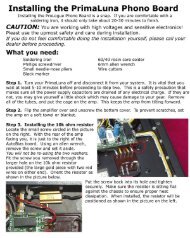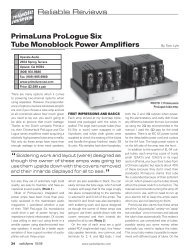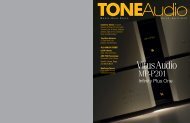PrimaLuna DiaLogue Two Integrated Tube Amplifier
PrimaLuna DiaLogue Two Integrated Tube Amplifier
PrimaLuna DiaLogue Two Integrated Tube Amplifier
Create successful ePaper yourself
Turn your PDF publications into a flip-book with our unique Google optimized e-Paper software.
Associated<br />
Equipment:<br />
Analog<br />
Front End<br />
Analog Front End<br />
Michell Orbe SE II<br />
turntable<br />
Wilson Benesch Act 0.5<br />
tone arm<br />
Benz-Micro Ebony L<br />
Luxman P-405 turntable<br />
Audio-Technica PB12S<br />
cartridge<br />
Digital Front End<br />
CAL Icon MkII (as<br />
transport)<br />
Bolder Cable modified<br />
ART DI/O processor<br />
Amplification<br />
Musical Surroundings<br />
Nova Phonomena<br />
Parasound P/LD 2000<br />
line stage<br />
Antique Sound Lab<br />
AQ1003 DT<br />
Kavent A210 hybrid<br />
integrated amplifier<br />
NuForce Reference 9V2<br />
SE<br />
Loudspeakers<br />
Silverline Prelude II<br />
Cabling<br />
<strong>PrimaLuna</strong> <strong>DiaLogue</strong> <strong>Two</strong> <strong>Integrated</strong> <strong>Tube</strong> <strong>Amplifier</strong><br />
A Strong Case for <strong>Tube</strong>s<br />
June 2008<br />
Okay, I admit it—I read Jim Hannon’s review of the <strong>PrimaLuna</strong> <strong>DiaLogue</strong><br />
<strong>Two</strong> integrated tube amplifier in the October 2007 issue of The Absolute<br />
Sound magazine. And although I don’t lend automatic credence to any<br />
review I see in print, the review did get me interested enough to request<br />
a review sample and to see for myself whether or not all the <strong>PrimaLuna</strong><br />
hype is justified.<br />
Make no mistake; the <strong>DiaLogue</strong> <strong>Two</strong> is a thoroughly modern amplifier<br />
that includes a very hefty anodized aluminum remote control. It was<br />
designed in the Netherlands by Herman van den Dungen and is<br />
manufactured to stringent standards in China.
Sonoran digital coax<br />
Audio Metallurgy GA-0<br />
Interconnects<br />
Audio Metallurgy Gold<br />
Reference speaker cables<br />
SignalCable Silver<br />
Resolution and Analog<br />
<strong>Two</strong> interconnects<br />
SignalCable Silver<br />
Resolution speaker<br />
cables<br />
Speltz Anti-Cable<br />
speaker cables<br />
(Silverline’s bass section)<br />
SignalCable MagicPower<br />
AC and Digital AC cords<br />
AC Conditioners<br />
Monarchy AC-regenerator<br />
PS Audio Duet and UPC<br />
200 AC filters<br />
EFI Electronics ACpower<br />
filter<br />
Accessories<br />
Plateau equipment rack<br />
Black Diamond Racing<br />
Source Shelf<br />
Andy Bartha Audio<br />
Whatchamacallits<br />
Black Diamond Racing<br />
#4 cones<br />
VanEvers wood-block kit<br />
Shakti Stones<br />
Blue Circle Cable Pillows<br />
Helmholtz resonators<br />
(homemade)<br />
Michael Green Room<br />
Tune<br />
Sonex panels<br />
What we have here folks, is a 38-watt per channel integrated tube<br />
amplifier, that uses two Chinese KT88 per channel (patterned after the<br />
British Genalex KT88s) to develop its rated power into 8 ohms. One can<br />
switch from the 38-watt ultralinear mode via a push of the button on the<br />
remote, which cuts power down to 21 watts per channel triode. The<br />
input section uses two 12AX7 and two 12AU7 tubes.<br />
From the get-go it was apparent that this was a very solid and well-built<br />
amplifier. Weighing in at a robust 64 pounds, with its oversized power<br />
and output transformers and thick aluminum faceplate, it certainly<br />
makes an impression the first time you have to lift it and carry it up a<br />
flight of stairs.<br />
The heavy-gauge polished steel chassis is coated in a 5-step process<br />
with an automobile-grade dark blue paint. High quality parts are used<br />
throughout from the extra large half-speed wound output transformers<br />
to the ceramic tube sockets, Alps potentiometer, Nichicon and Solen<br />
capacitors, and WBT-style speaker terminals. Gold plated input jacks.<br />
The <strong>DiaLogue</strong> <strong>Two</strong> is hand-made and point to point wired although it<br />
does contain a couple of internal printed circuit boards, one notably for<br />
the unique “Adaptive AutoBias” circuit, which is claimed to optimize<br />
valve performance and reduce distortion by 40 to 50%. It also extends<br />
tube life and makes the unit more reliable and user-friendly.<br />
Here’s the cool thing about the Adaptive AutoBias – almost any output<br />
tube can be plugged in and played. This unique biasing circuit will sense<br />
the tube type and automatically set the bias for optimal operation. You<br />
don’t need to do anything other than install your favorite tubes, then sit<br />
back and enjoy! In addition to KT88s, the amp can use 6550, KT90, EL-<br />
34, KT77, 6CA7, 6L6GC, KT66, 7581, and 6V6GT tubes, or any of their
equivalents. Talk about a tube-roller’s paradise!<br />
Features:<br />
The <strong>DiaLogue</strong> <strong>Two</strong> has a rotary volume control and six switched inputs,<br />
which include a HT input that bypasses the volume control and the tube<br />
input section. Therefore, when using the HT input, the source must have<br />
its own volume control if you don’t intend the <strong>DiaLogue</strong> <strong>Two</strong> to play into<br />
your speakers and ears at FULL VOLUME!<br />
One very nice extra cost option is the installation of a very articulate and<br />
musical MM phono stage (more on this later). The $199 extra was<br />
installed on my review sample on AUX 2. The rocker off/on switch is on<br />
the front left side of the chassis and is not controlled by the remote<br />
control.<br />
The rear panel contains 6 pairs of gold-plated RCA inputs and one pair of<br />
RCA tape outputs plus a grounding post. There are WBT style speaker<br />
posts for 4 or 8 ohms, and an IEC AC receptacle to facilitate aftermarket<br />
power cords (I found the stock cord to sound very respectable).<br />
The <strong>DiaLogue</strong> <strong>Two</strong> contains internal AC and plate fuses, and a few spare<br />
fuses are included in the package, as are a pair of white handling gloves.<br />
The remote is an<br />
attractive blackanodized<br />
heavy-metal<br />
unit that is quite useful.<br />
In addition to the usual<br />
volume control, you can<br />
choose inputs, mute and<br />
un-mute, and switch<br />
from ultralinear to triode<br />
operation at the push of<br />
a button. It appears to<br />
have other transport<br />
control buttons that will<br />
conveniently operate the<br />
<strong>PrimaLuna</strong> CD player.<br />
The remote has rubber<br />
rings installed at each<br />
end so that it won’t<br />
scratch your furniture. Nice touch.<br />
I did some experimenting with the ultralinear to triode switching and<br />
found the triode mode to be generally a bit warmer and slightly sweeter<br />
sounding. It seemed to work well for low level listening and for acoustic<br />
singer/songwriter music. The ultralinear mode was used for most of my<br />
evaluation because it provides greater power and better articulation at<br />
the frequency extremes.<br />
Notes on Impedance and <strong>Tube</strong>-Rolling:<br />
The first thing one needs to determine when installing the <strong>DiaLogue</strong> <strong>Two</strong><br />
in a system, is whether to use the 4-ohm or 8-ohm speaker posts. This<br />
would seem perfectly straight forward, but in my experience it was not<br />
exactly the case.<br />
Since my Silverline Prelude speakers have a nominal 8-ohm rating, I<br />
started with the 8-ohm taps. In that configuration, the <strong>DiaLogue</strong> <strong>Two</strong><br />
sounded very matter-of-fact and very similar to many solid-state<br />
amplifiers. The sound was clean and extended at the frequency<br />
extremes, but the harmonic sweetness I had expected to hear from the<br />
<strong>DiaLogue</strong> <strong>Two</strong> was somehow missing in action.
Changing my speaker wire to the 4-ohm terminals allowed the amplifier to sound<br />
sweeter and much more like a very good tube amplifier. So, since my 8-ohm Preludes<br />
seemed to prefer the 4-ohm setting (I know I did!) I used the 4-ohm taps for the<br />
remainder of my evaluation. My advice is not to assume anything and to try both<br />
impedance settings to determine which sounds best to you.<br />
The Chinese KT-88 Genalex knock-offs performed very well in my system. The midrange<br />
was a bit forward, but the bass extension and articulation was quite healthy and the high<br />
frequencies were airy, non-fatiguing, and extended, without any obvious roll off. What<br />
I’m saying is that the stock KT-88s provide very respectable performance in the<br />
<strong>DiaLogue</strong> <strong>Two</strong>, which will satisfy many. Buyers should not feel that they need to run<br />
right out and buy some expensive NOS tube set.<br />
But since I simply had to try out that Adaptive AutoBias circuit, I pulled a quad of JJ<br />
EL34 tubes from my Antique Sound Lab AQ1003 DT (ASL) amp and plugged them into<br />
the <strong>DiaLogue</strong> <strong>Two</strong>.<br />
I powered up the <strong>DiaLogue</strong> <strong>Two</strong> with the EL34s and began listening. Now this was truly a<br />
sweet sound. The JJ EL34s sounded both sweet and natural in the ASL amp, and also<br />
gave a nice sense of depth projection. The highs were natural and extended, though not<br />
as extended as the new KT88s, but nonetheless, they provided quite a bit of detail and<br />
shimmer on cymbals and other high-frequency instruments. The midrange was, in a<br />
word, “gorgeous,” and in my room, the EL34s provided bass that was fairly equal to that<br />
of the KT88s, and perhaps it was even a bit more articulate.<br />
Moving on to a quad of vintage Genalex KT66 gray-plate tubes, the sound became very<br />
detailed, but also very forward, and lost a bit of bass extension and punch. This was my<br />
least favorite tube match for this particular system.<br />
So it is true that you can plug virtually any type of output tube into the <strong>DiaLogue</strong> <strong>Two</strong><br />
and it will play just fine. It is also true (as with all tube amps) that each different tube<br />
type will have its own distinct character. Which one will sound the best to you will<br />
depend on your associated gear and your listening biases.<br />
As for me, I was very impressed with the overall sound of the EL34 tubes in my system<br />
and consequently went on to use that tube set for the rest of my evaluation. They<br />
provided a bit more harmonic richness than the KT88s in the crucial midrange, and were<br />
just a touch more laid-back sounding.<br />
Let the Games Begin<br />
I began listening to the <strong>DiaLogue</strong> <strong>Two</strong> with some familiar CDs. I was quite impressed<br />
with the amplifier, which offered more bass extension and punch and certainly more<br />
extended high frequencies than my ASL tube amplifier. But what impressed me the most<br />
about the <strong>DiaLogue</strong> <strong>Two</strong> was its near solid-state control of the bass combined with an<br />
uncanny ability to reproduce midrange notes, such as guitar chords, with a bit more<br />
power and dynamic flair than I had experienced with most other amplifiers. It quickly<br />
became apparent that this was going to be a thoroughly enjoyable evaluation. Indeed,<br />
the <strong>DiaLogue</strong> <strong>Two</strong> sounds more dynamic and actually has better bass control than some<br />
solid-state amplifiers I’ve had in my system<br />
A Shocking Revelation!<br />
<strong>PrimaLuna</strong>’s USA Distributor Kevin Deal offered to install the optional phono board in my<br />
<strong>DiaLogue</strong> <strong>Two</strong>, and being an analogue man from way back, how could I refuse? The MM<br />
Phono was installed on the AUX2 input, which was as good a choice as any.<br />
Kevin had enticed me by telling me that this phono board, which is made in Holland,<br />
works particularly well in the <strong>DiaLogue</strong> <strong>Two</strong>. It boasts a very high-quality op-amp,<br />
minimelf resistors, and a very short signal path. Although it is a solid-state circuit, my<br />
personal philosophy supports this approach (solid-state phono into a tube line stage). In<br />
my view, it keeps noise levels very low and provides better detail and articulation in the<br />
high and low frequency registers.
Keep in mind that I had my Michell Orbe SE with the Wilson Benesch ACT 0.1 arm, Benz<br />
Ebony L MC cartridge, and Musical Surroundings Nova Phonomena phono stage hooked<br />
up on the <strong>DiaLogue</strong> <strong>Two</strong>’s direct HT input. At first, the only turntable I had set up for MM<br />
I cued up a Laura Brannigan’s Brannigan 2 LP (Atlantic 7 80052-1) and was<br />
flabbergasted when the needle hit the record and began playing “Solitaire.” I must say<br />
that Laura’s vocal and the backing instruments sounded jaw-droppingly musical and<br />
natural through the <strong>DiaLogue</strong> <strong>Two</strong>’s phono section. And when we got to “Squeezebox,”<br />
and the “squeezebox” made its entrance, the reproduction was smoother and more<br />
holographic than it had any right to be. With respect to the critical midrange<br />
reproduction, the <strong>DiaLogue</strong> <strong>Two</strong> phono was strutting its stuff big time. Even the lows and<br />
highs were as good as I’d ever heard them with this particular cartridge (though the<br />
midrange is its strength).<br />
A few days later, I bought a used Luxman P-405 automatic belt-drive turntable from<br />
Craig’s List, and installed my mighty vintage Audio-Technica PB-12S cartridge with its<br />
Shibata stylus. As I recall, it received a good write up from TAS back in the day.<br />
This time, I had my music-friend Mike and his lovely wife Kyle over to check out the<br />
system. Mike had brought some premium quality MFSL records and we played Boston’s<br />
original LP as well as one by Stevie Nicks. To me, the sound was decent, maybe a touch<br />
on the bright side, but really nothing too special.<br />
So I said to Mike and Kyle, “How about if I put something on that’ll rip your heads off?”<br />
They looked at each other suspiciously, and then turned and said, “Uh, okay.” “Sweet,”<br />
said I.<br />
I then dove into my 80’s 12-inch-single dance music collection and pulled out Jody<br />
Watley’s Real Love (MCA 23928). I cranked the volume a bit and then pressed the Start<br />
button on the Luxman. The song began with Jody talking, then some loud cymbals after<br />
which the bombastic bass line kicked in. I looked at Mike and he said, “I think the bass<br />
may be overloading the room a little.” I considered his veiled request for a volume<br />
reduction momentarily, then retorted, “That’s right bitch—Take that!” “Oh-Oh-Aaaah,”<br />
Watley wailed! It really was surprising how LOUD the <strong>DiaLogue</strong> <strong>Two</strong> could play the<br />
Preludes in my 11’x14’ room. And not only was the sound loud, it was clean and<br />
controlled.<br />
My point is that the <strong>DiaLogue</strong> <strong>Two</strong>’s phono is a surprisingly great sounding addition. It<br />
provides a wealth of detail, impressive dynamic contrasts, and a wonderfully musical and<br />
dimensional midrange. I would expect it to equal or surpass outboard units up to $1000.<br />
The real truth (if I must tell it) is that the seductive sound of the <strong>PrimaLuna</strong>’s phono<br />
stage had me checking and double-checking all the settings and adjustments on my<br />
much more expensive Nova Phonomena and Michell Orbe. I mean hell; the Orbe had to<br />
sound better than the Sony or the Luxman, right? And it did—after resetting the VTA,<br />
the tracking force, and the loading value.<br />
Once I had recalibrated the Orbe, it sounded truly inspirational. Playing Stravinsky’s L’<br />
Histoire du Soldat, performed by the Columbia Symphony Orchestra from Stravinsky<br />
Conducts, 1961 (Columbia MS 6272) the coronet and the trombone had a richness and<br />
texture that I’ve rarely experienced. And the tympani, cymbals, and other drums<br />
sounded very poignant and convincing. I could easily hear the tuning of the skins on the<br />
various drums. In one movement there is a drum roll that just comes out of nowhere<br />
and is shocking in its level of transparency.<br />
When I put the record back, I noticed that I had an Everest-labeled copy of the same<br />
piece (Everest SDBR - 3017) performed by the London Symphony Orchestra. The<br />
Everest recordings are renowned for being among the world’s best. This particular<br />
recording was mastered at the Belock Recording Studio using Ampex 300 stereo tape<br />
machines recording on half-inch tape via microphones from AGK, Telefunken, and<br />
Neumann.
I played the same movements of L’ Histoire that I had just listened to on the other<br />
recording and it was very evident that as good as the first recording was, the Everest<br />
recording was a considerable step up. The brass, woodwinds, and violins were so<br />
immediate and detailed, and the drums so palpable that I had to suspend disbelief in<br />
order to believe that I was not witnessing the actual concert. In truth, the quality of the<br />
reproduction was about as good as it gets.<br />
I realize that I was listening to two different orchestras recorded in two different venues,<br />
but still, the difference in recording quality was unmistakable. It seemed that the Everest<br />
recording likely used a different microphone configuration with better quality<br />
microphones, resulting in more apparent detail and intimacy.<br />
Caveats<br />
The <strong>DiaLogue</strong> <strong>Two</strong> is a very hard product to fault, but I wouldn’t be a reviewer if I<br />
couldn’t find some small things to complain about, so here goes.<br />
First, I would prefer to have a pair of volume-controlled preamp outputs instead of the<br />
fixed-volume tape outputs.<br />
Second, I wish that the source selector defaulted to the last selected source at turn-on<br />
instead of automatically reverting back to the CD input.<br />
Although the tube cage is uniquely styled, modern, and very functional, it’s just not my<br />
idea of eye-candy. Luckily it pulls up and off quite easily.<br />
Summary<br />
My hat is off to the folks at <strong>PrimaLuna</strong>. What impresses me most about the <strong>DiaLogue</strong><br />
<strong>Two</strong> amplifier is how well though out and executed this product truly is. It seems that<br />
the designer left no stone unturned when it came to considering what modern users<br />
would desire and look for in a tube integrated. From the Adaptive AutoBias circuit, to the<br />
verily useful remote control with on-the-fly UL/triode switching; then last, but far from<br />
least, the provision for an excellent low-cost onboard MM phono stage, the <strong>DiaLogue</strong> <strong>Two</strong><br />
is a bona fide home run all the way.<br />
As if all of the above are insufficient reasons to make a semi-expensive purchase, the<br />
clincher is the gorgeous musical presentation that this amplifier provides all day long. Its<br />
dynamic contrasts are among the best I’ve encountered; and although its midrange is<br />
beauteous, its superb articulation and command of the frequency extremes is what puts<br />
it ahead of the competition. Accordingly, I’ve committed to purchase the <strong>PrimaLuna</strong><br />
Dialogue <strong>Two</strong>. I will surely enjoy it as my prime tube reference amplifier.
Specifications<br />
Output: 38 watts x 2 ultralinear, 21 watts x 2 triode<br />
Freq. Response: 10Hz-30kHz +/- .5dB<br />
THD: Less than 1% at full power<br />
S/N Ratio: 89dB<br />
Input Sensitivity: 270mV<br />
Power Consumption : 250 watts<br />
Dimensions: 15.2" x 8.3 " x 16 " (WxHxD)<br />
Weight: 63.8 lbs<br />
Inputs: 5 pair RCA / 1 pair HT bypass<br />
Outputs: 4 & 8 Ohm speaker taps / 1 pair RCA fixed tape output<br />
<strong>Tube</strong> Compliment: 2 - 12AX7, 2 - 12AU7, 4 - KT88<br />
Price: $2,625 USD; Phono adds $199<br />
US Distributor:<br />
Kevin Deal<br />
<strong>PrimaLuna</strong> USA<br />
2504 Spring Terrace<br />
Upland, CA. 91784<br />
USA<br />
Phone: 909-931-9686<br />
FAX: 909-985-6968<br />
Web: www.primaluna-usa.com


